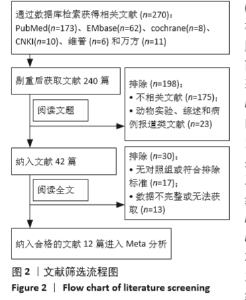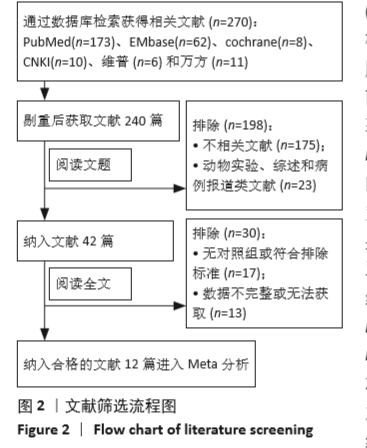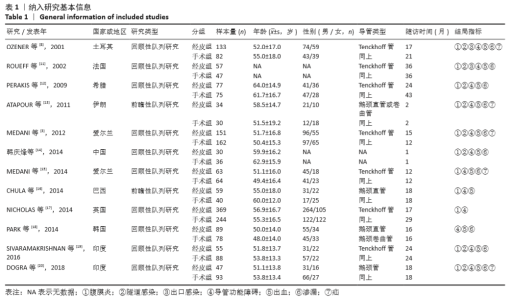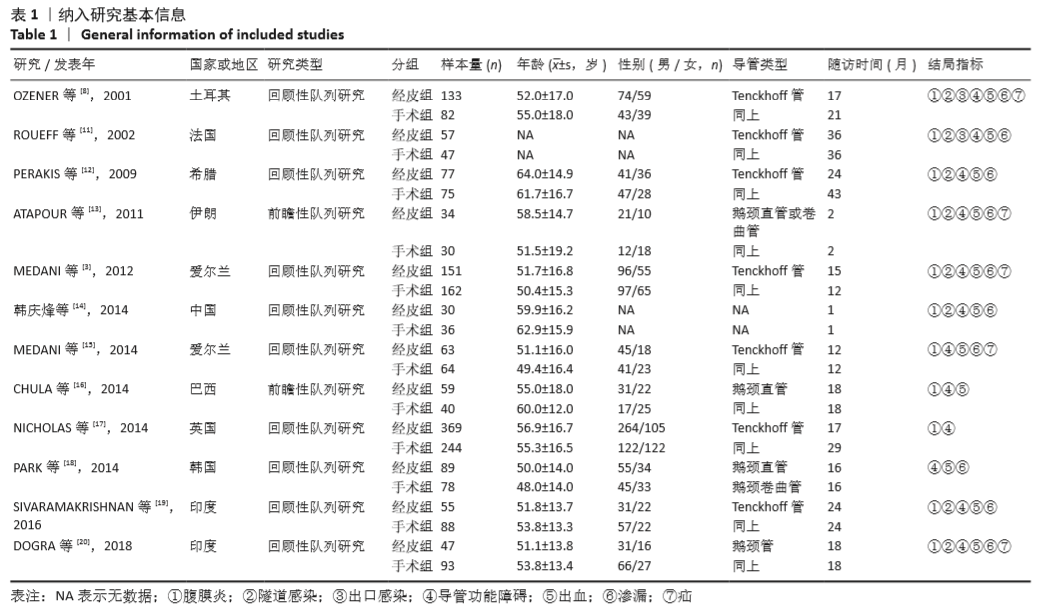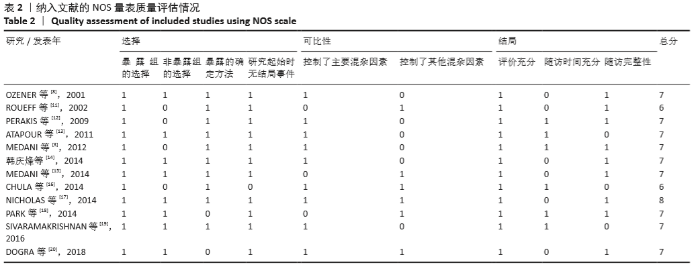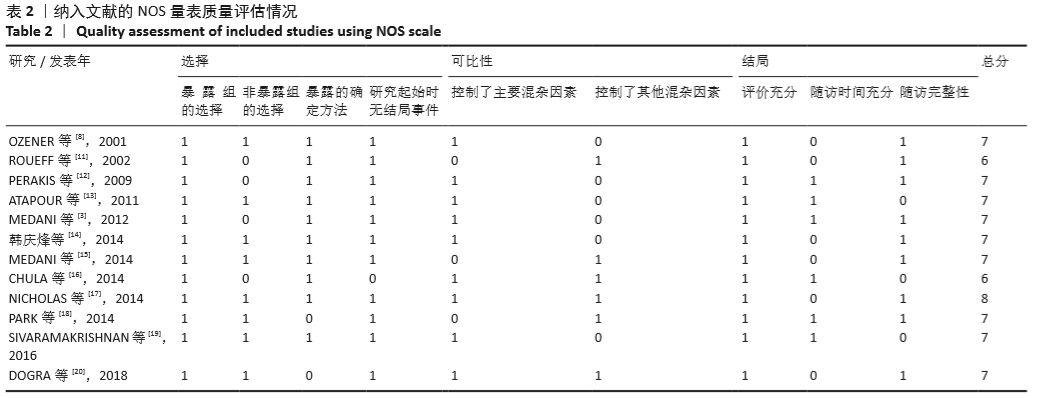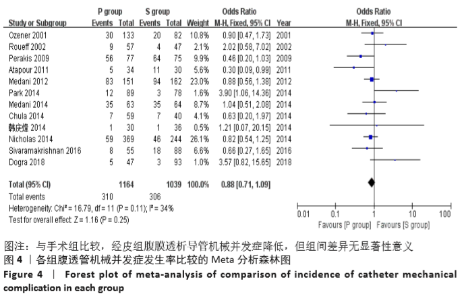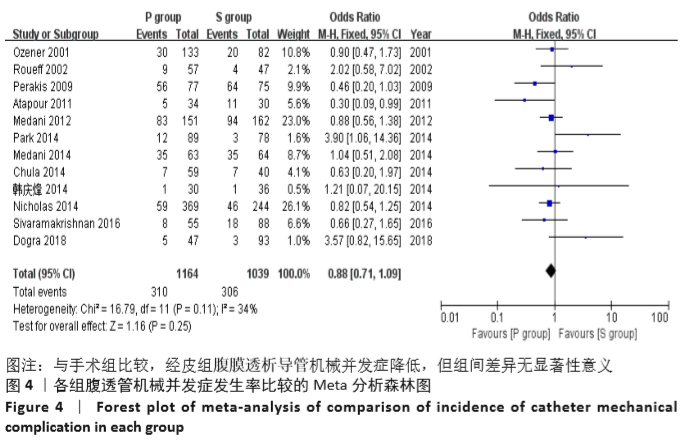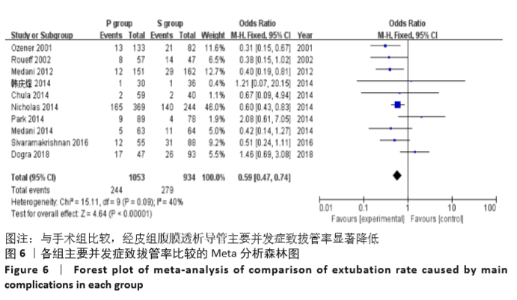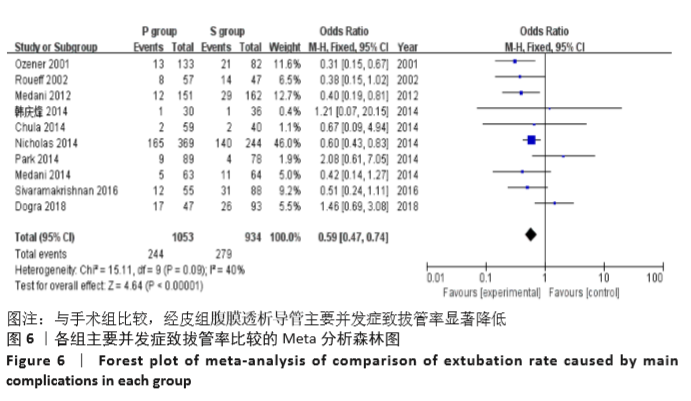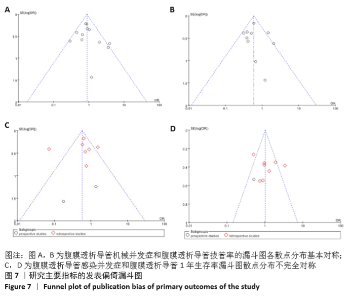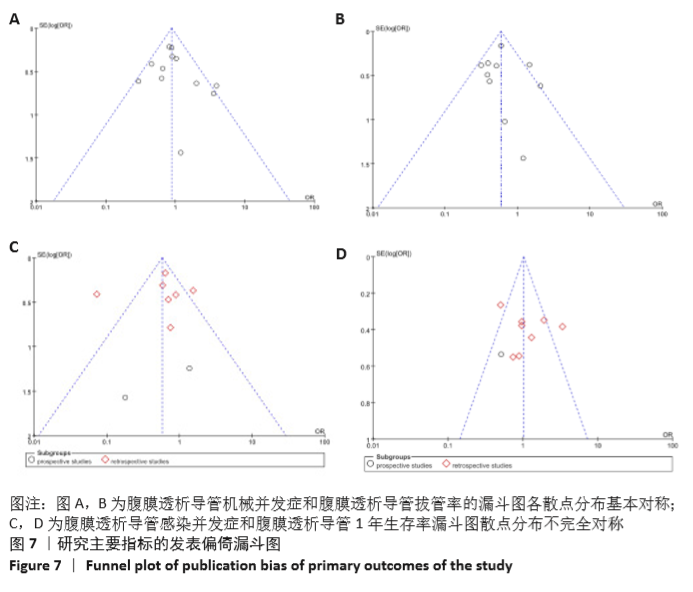Chinese Journal of Tissue Engineering Research ›› 2021, Vol. 25 ›› Issue (28): 4567-4572.doi: 10.12307/2021.074
Previous Articles Next Articles
Effects of different peritoneal dialysis catheterization techniques on the prognosis of patients: a meta-analysis
Du Yuan1, 2, Jiang Hongwei1, Li Chunqing1, Xie Yan2
- 1Department of Nephrology, Affiliated Hospital of Jiangnan University, Wuxi 214041, Jiangsu Province, China; 2Department of Geriatrics, First Affiliated Hospital of Suzhou University, Suzhou 215006, Jiangsu Province, China
-
Received:2020-06-09Revised:2020-06-13Accepted:2020-08-04Online:2021-10-08Published:2021-05-22 -
Contact:Xie Yan, Professor, Chief physician, Department of Geriatrics, First Affiliated Hospital of Suzhou University, Suzhou 215006, Jiangsu Province, China -
About author:Du Yuan, Associate chief physician, Department of Nephrology, Affiliated Hospital of Jiangnan University, Wuxi 214041, Jiangsu Province, China; Department of Geriatrics, First Affiliated Hospital of Suzhou University, Suzhou 215006, Jiangsu Province, China
CLC Number:
Cite this article
Du Yuan, Jiang Hongwei, Li Chunqing, Xie Yan. Effects of different peritoneal dialysis catheterization techniques on the prognosis of patients: a meta-analysis[J]. Chinese Journal of Tissue Engineering Research, 2021, 25(28): 4567-4572.
share this article
Add to citation manager EndNote|Reference Manager|ProCite|BibTeX|RefWorks
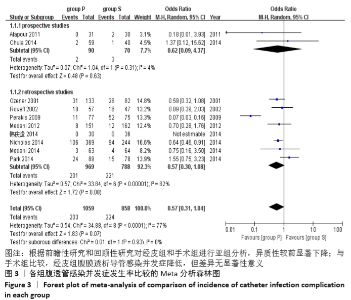
2.3.1 各组腹膜透析导管感染并发症发生率差异 有10篇文献比较了经皮组和手术组腹膜透析导管相关感染并发症的发生率[3,8,11-18]。共纳入1 917例患者,经皮组1 059例,手术组858例。各研究间异质性差异有显著性意义(I2=77%,P < 0.000 1),故采用随机效应模型进行Meta分析。结果显示:在腹膜透析导管相关感染并发症的发生率方面,经皮组略低于手术组,但组间无显著性差异(OR=0.57,95%CI:0.31-1.04,P=0.07);根据研究类型的不同,将纳入的文献分成前瞻性研究亚组和回顾性研究亚组(下同)进行亚组分析,结果表明:异质性较前明显下降(I2=0%,P=0.93),亚组内比较,经皮组感染率均与手术组相似(OR=0.62,95%CI:0.09-4.37,P=0.63;OR=0.57,95%CI:0.30-1.08,P=0.08),差异无显著性意义,见图3。"
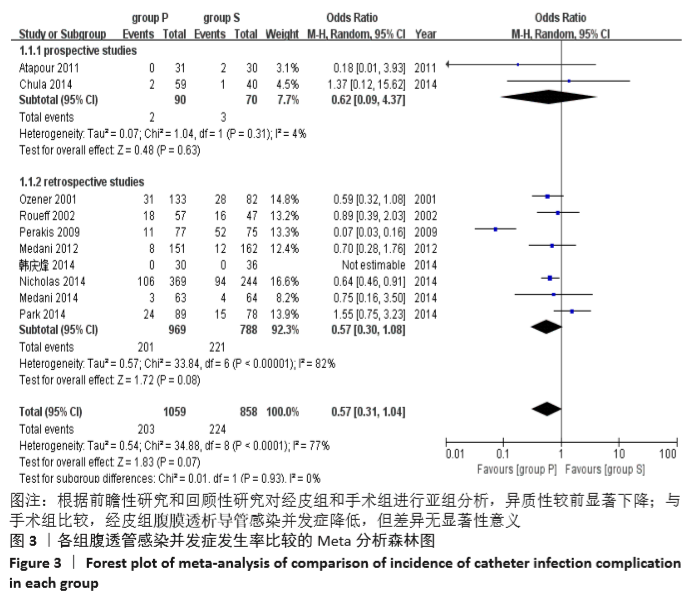
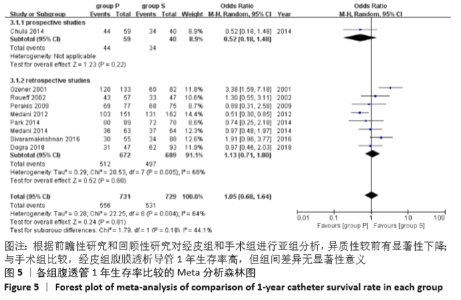
2.3.3 各组腹膜透析导管1年生存率差异 有9篇文献比较了经皮组和手术组腹膜透析导管1年生存率的情况[3,8,11-12,15-16,18-20]。共纳入1 460例患者,经皮组731例,手术组729例。各研究间异质性有显著性差异(P=0.004,I2=64%),故采用随机效应模型进行Meta分析。结果显示:在导管1年生存率方面,经皮组略高于手术组,但无显著性差异(OR=1.05,95%CI:0.68-1.64,P=0.81);亚组分析显示:异质性较前有明显下降(P=0.18,I2=44.1%),亚组内,经皮组和手术组的导管1年生存率相似(OR=0.52,95%CI:0.18-1.48,P=0.22;OR=1.13,95%CI:0.71-1.80,P=0.6),组间差异均无显著性意义,见图5。"
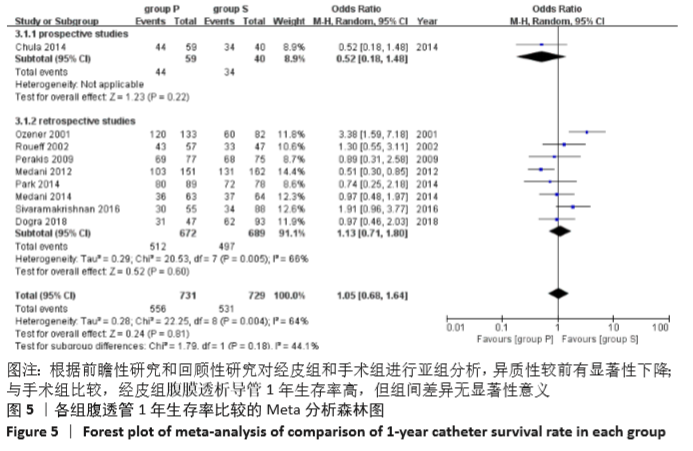
| [1] CRABTREE JH, CHOW KM. Peritoneal dialysis catheter insertion. Semin nephrol. 2017;37(1):17-29. [2] PYART R, DONOVAN K, CARRINGTON C, et al. Peritoneal dialysis: turning choice into reality. Perit Dial int. 2018;38(5):328-333. [3] MEDANI S, SHANTIER M, HUSSEIN W, et al. A comparative analysis of percutaneous and open surgical techniques for peritoneal catheter placement. Perit Dial Int. 2012;32(6):628-635. [4] OUYANG CJ, HUANG FX, YANG QQ, et al. Comparing the incidence of catheter-related complications with straight and coiled tenckhoff catheters in peritoneal dialysis patients-a single-center prospective randomized trial. Perit Dial Int. 2015;35(4):443-449. [5] SHANMUGALINGAM R, MAKRIS A, HASSAN HC, et al. The utility of sonographic assessment in selecting patients for percutaneous insertion of peritoneal dialysis catheter. Perit Dial Int. 2017;37(4):434-442. [6] SALGAONKAR HP, BEHERA R R, SHARMA PC, et al. Minimally invasive surgery for salvage of malfunctioning peritoneal dialysis catheters. J Minim Access Surg. 2019;15(1):19-24. [7] PERL J, PIERRATOS A, KANDASAMY G, et al. Peritoneal dialysis catheter implantation by nephrologists is associated with higher rates of peritoneal dialysis utilization: a population-based study. Nephrol Dial Transplant. 2015;30(2):301-309. [8] OZENER C, BIHORAC A, AKOGLU E. Technical survival of CAPD catheters: comparison between percutaneous and conventional surgical placement techniques. Nephrol Dial Transplant. 2001;16(9):1893-1899. [9] 中国超重/肥胖医学营养治疗专家共识编写委员会.中国超重/肥胖医学营养治疗专家共识(2016年版)[J].中华糖尿病杂志,2016,8(9): 525-540. [10] COOK DA, REED DA. Appraising the quality of medical education research methods: the Medical Education Research Study Quality Instrument and the Newcastle-Ottawa Scale-Education. Acad Med. 2015;90(8):1067-1076. [11] ROUEFF S, PAGNIEZ D, MORANNE O, et al. Simplified percutaneous placement of peritoneal dialysis catheters: comparison with surgical placement. Perit Dial Int. 2002;22(2):267-269. [12] PERAKIS KE, STYLIANOU KG, KYRIAZIS JP, et al. Long-term complication rates and survival of peritoneal dialysis catheters: the role of percutaneous versus surgical placement. Seminars in Dialysis. 2009;22(5): 569-575. [13] ATAPOUR A, ASADABADI H R, KARIMI S, et al. Comparing the outcomes of open surgical procedure and percutaneously peritoneal dialysis catheter (PDC) insertion using laparoscopic needle: a two month follow-up study. J Res Med Sci. 2011;16(4):463-468. [14] 韩庆烽,孙玲华,聂建东,等.经皮穿刺腹膜透析置管术的临床应用[J].中国血液净化,2014, 13(10):686-688. [15] MEDANI S, HUSSEIN W, SHANTIER M, et al. Comparison of percutaneous and open surgical techniques for first-time peritoneal dialysis catheter placement in the unbreached peritoneum. Perit Dial Int. 2015;35(5):576-585. [16] CHULA DC, CAMPOS RP, DE ALCANTARA MT, et al. Percutaneous and surgical insertion of peritoneal catheter in patients starting in chronic dialysis therapy: a comparative study. Semin Dial. 2014; 27(3):E32-E37. [17] NICHOLAS J, THOMAS M, ADKINS R, et al. Percutaneous and surgical peritoneal dialysis catheter placements have comparable outcomes in the modern era. Perit Dial Int. 2014;34(5):552-556. [18] PARK YS, MIN SI, KIM DK, et al. The outcomes of percutaneous versus open placement of peritoneal dialysis catheters. World J Surg. 2014; 38(5):1058-1064. [19] SIVARAMAKRISHNAN R, GUPTA S, AGARWAL SK, et al. Comparison of outcomes between surgically placed and percutaneously placed peritoneal dialysis catheters: a retrospective study. Indian J Nephrol. 2016;26(4):268-274. [20] DOGRA PM, HOODA AK, SHANMUGRAJ G, et al. Continuous ambulatory peritoneal dialysis catheter insertion technique: a comparative study of percutaneous versus surgical insertion. Indian J Nephrol. 2018;28(4):291-297. [21] KIM YS, KIM Y, SHIN SJ, et al. Current state of dialysis access management in Korea. J Vasc Access. 2019; 20(1-suppl):15-19. [22] LEE YK, YANG PS, PARK KS, et al. Modified peritoneal dialysis catheter insertion: comparison with a conventional method. Yonsei Med J. 2015; 56(4):981-986. [23] BRIGGS V, PITCHER D, BRADDON F, et al. UK Renal Registry 15th annual report: Chapter 8 UK multisite peritoneal dialysis access catheter audit for first PD catheters 2011. Nephron Clin Pract. 2013;123(Suppl 1):165-181. [24] GEORGE N, ALEXANDER S, DAVID VG, et al. Comparison of early mechanical and infective complications in first time blind, bedside, midline percutaneous tenckhoff catheter insertion with ultra-short break-in period in diabetics and non-diabetics: setting new standards. Perit Dial Int. 2016;36(6):655-661. [25] TOKGOZ B. Clinical advantages of peritoneal dialysis. Perit Dial Int. 2009;29 Suppl 2:S59-61. [26] CRABTREE J, PENNER T, ARMSTRONG S, et al. Peritoneal dialysis university for surgeons: a peritoneal access training program. Peri Dial Int. 2016;36(2):177-181. [27] ABDEL-AAL AK, GADDIKERI S, SADDEKNI S. Technique of peritoneal catheter placement under fluroscopic guidance. Radiol Res Pract. 2011;2011:141707. [28] VOSS D, HAWKINS S, POOLE G, et al. Radiological versus surgical implantation of first catheter for peritoneal dialysis: a randomized non-inferiority trial. Nephrol Dial Transplant. 2012;27(11):4196-4204. [29] TULLAVARDHANA T, AKRANURAKKUL P, UNGKITPHAIBOON W, et al. Surgical versus percutaneous techniques for peritoneal dialysis catheter placement: a meta-analysis of the outcomes. Ann Med Surg (Lond). 2016;10:11-18. [30] DE MORAES TP, CAMPOS RP, DE ALCANTARA MT, et al. Similar outcomes of catheters implanted by nephrologists and surgeons: analysis of the Brazilian peritoneal dialysis multicentric study. Semin Dialy. 2012;25(5):565-568. |
| [1] | Chen Junming, Yue Chen, He Peilin, Zhang Juntao, Sun Moyuan, Liu Youwen. Hip arthroplasty versus proximal femoral nail antirotation for intertrochanteric fractures in older adults: a meta-analysis [J]. Chinese Journal of Tissue Engineering Research, 2021, 25(9): 1452-1457. |
| [2] | Chen Jinping, Li Kui, Chen Qian, Guo Haoran, Zhang Yingbo, Wei Peng. Meta-analysis of the efficacy and safety of tranexamic acid in open spinal surgery [J]. Chinese Journal of Tissue Engineering Research, 2021, 25(9): 1458-1464. |
| [3] | Hu Kai, Qiao Xiaohong, Zhang Yonghong, Wang Dong, Qin Sihe. Treatment of displaced intra-articular calcaneal fractures with cannulated screws and plates: a meta-analysis of 15 randomized controlled trials [J]. Chinese Journal of Tissue Engineering Research, 2021, 25(9): 1465-1470. |
| [4] | Huang Dengcheng, Wang Zhike, Cao Xuewei. Comparison of the short-term efficacy of extracorporeal shock wave therapy for middle-aged and elderly knee osteoarthritis: a meta-analysis [J]. Chinese Journal of Tissue Engineering Research, 2021, 25(9): 1471-1476. |
| [5] | Wang Yongsheng, Wu Yang, Li Yanchun. Effect of acute high-intensity exercise on appetite hormones in adults: a meta-analysis [J]. Chinese Journal of Tissue Engineering Research, 2021, 25(8): 1305-1312. |
| [6] | Kong Desheng, He Jingjing, Feng Baofeng, Guo Ruiyun, Asiamah Ernest Amponsah, Lü Fei, Zhang Shuhan, Zhang Xiaolin, Ma Jun, Cui Huixian. Efficacy of mesenchymal stem cells in the spinal cord injury of large animal models: a meta-analysis [J]. Chinese Journal of Tissue Engineering Research, 2021, 25(7): 1142-1148. |
| [7] | Huang Dengcheng, Wang Zhike, Cao Xuewei. Intravenous, topical tranexamic acid alone or their combination in total knee arthroplasty: a meta-analysis of randomized controlled trials [J]. Chinese Journal of Tissue Engineering Research, 2021, 25(6): 948-956. |
| [8] | Li Yan, Wang Pei, Deng Donghuan, Yan Wei, Li Lei, Jiang Hongjiang. Electroacupuncture for pain control after total knee arthroplasty: a meta-analysis [J]. Chinese Journal of Tissue Engineering Research, 2021, 25(6): 957-963. |
| [9] | He Xiangzhong, Chen Haiyun, Liu Jun, Lü Yang, Pan Jianke, Yang Wenbin, He Jingwen, Huang Junhan. Platelet-rich plasma combined with microfracture versus microfracture in the treatment of knee cartilage lesions: a meta-analysis [J]. Chinese Journal of Tissue Engineering Research, 2021, 25(6): 964-969. |
| [10] | Hua Haotian, Zhao Wenyu, Zhang Lei, Bai Wenbo, Wang Xinwei. Meta-analysis of clinical efficacy and safety of antibiotic artificial bone in the treatment of chronic osteomyelitis [J]. Chinese Journal of Tissue Engineering Research, 2021, 25(6): 970-976. |
| [11] | Zhan Fangbiao, Cheng Jun, Zou Xinsen, Long Jie, Xie Lizhong, Deng Qianrong. Intraoperative intravenous application of tranexamic acid reduces perioperative bleeding in multilevel posterior spinal surgery: a meta-analysis [J]. Chinese Journal of Tissue Engineering Research, 2021, 25(6): 977-984. |
| [12] | Yuan Chunhua, Cui Zhenzhen, Wu De. Meta-analysis of autologous bone marrow mesenchymal stem cell transplantation in the treatment of ischemic stroke [J]. Chinese Journal of Tissue Engineering Research, 2021, 25(31): 5018-5024. |
| [13] | Zhong Yuanming, Wan Tong, Zhong Xifeng, Wu Zhuotan, He Bingkun, Wu Sixian. Meta-analysis of the efficacy and safety of percutaneous curved vertebroplasty and unilateral pedicle approach percutaneous vertebroplasty in the treatment of osteoporotic vertebral compression fracture [J]. Chinese Journal of Tissue Engineering Research, 2021, 25(3): 456-462. |
| [14] | Li Yang, Zhang Mingyong. Meta-analysis of the effect of double Endobutton and clavicular hook plate on the treatment of acromioclavicular dislocation [J]. Chinese Journal of Tissue Engineering Research, 2021, 25(3): 463-470. |
| [15] | Li Yanle, Yue Xiaohua, Wang Pei, Nie Weizhi, Zhang Junwei, Tan Yonghai, Jiang Hongjiang. Intramedullary nail fixation versus plate fixation in the treatment of displaced midshaft clavicular fractures in adults: a meta-analysis [J]. Chinese Journal of Tissue Engineering Research, 2021, 25(3): 471-476. |
| Viewed | ||||||
|
Full text |
|
|||||
|
Abstract |
|
|||||
